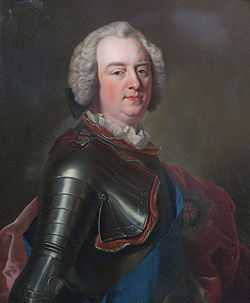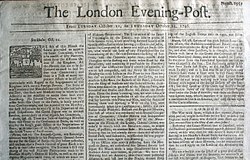Cricket in 1726

1726 was the first English cricket season in which a newspaper report named a participant in a match. The first players mentioned by name were Perry of London and Piper of Hampton, who played the sport's earliest known single wicket match. Brief reports have survived of two eleven-a-side matches. The main story of the year, as in some earlier seasons, concerns cricket's relationship with the law, and once again the issue was non-payment of gambling debts.
Background
By 1726, cricket had become an established sport in London and the south-eastern counties of England. It had also been played in India and North America by English colonists and sailors. The spread of cricket at home was limited by the constraints of travel at the time, but it was slowly gaining adherents in other parts of the country with references being found in many counties beyond the south-east, although it had apparently not reached the North of England yet.
Having been essentially a rural pastime for well over a century, cricket was becoming a focus for wealthy patrons such as the 2nd Duke of Richmond; and also for gamblers whose interests would fund its growth through the 18th century. Other famous patrons in the 1720s were Edwin Stead of Kent; Sir William Gage of Sussex; and Alan Brodrick of Surrey. Gambling was prevalent at cricket matches in Georgian England and many gambling- or alcohol-fuelled incidents occurred.[1] The issue was not addressed by the sport's ruling body until the 1770s and it remained a significant factor even then.[2] The other side of the coin was the reliance of cricket, as a professional sport, upon the investment accrued through gambling interests.
Media coverage

No cricket had been reported in the infant newspaper industry before 1697 due to the Licensing of the Press Act 1662 which controlled the press until 1696, but reports were beginning to increase by the mid-1720s, though it would be a very long time indeed before coverage became anything like comprehensive. The typical early report tended to be an advertisement for a scheduled match or else a brief discussion of the gambling odds rather than the actual play and it was not until 1726 that any player was mentioned by name in a newspaper report. The London Evening Post was founded in 1726 and carried a good many cricket notices until it ceased publication in 1797. The growth of the newspaper industry was important contemporarily for giving the sport much needed publicity and historically for providing glimpses into a developing sport that had still not learned how to record itself for posterity.
It was the London Evening Post, in its issue dated Saturday, 27 August 1726, that carried an advertisement for a single wicket match between players called "the noted Perry" (of London) and "the famous Piper" (of Hampton), playing "for twenty pounds a side". The match was played at Moulsey Hurst, a multi-sport venue near Molesey in Surrey. This is the first time that players are known to have been named in a newspaper and the match itself is the earliest known to have been played under single wicket rules.[3] Moulsey Hurst was especially famous for prizefighting, but it was often used for cricket throughout the 18th century.
County cricket
A feature of cricket in the 1720s was the increasing use by teams of county names. Teams called Kent and Surrey had been recorded as far back as 1709, though they were probably not representative of the whole counties.[4] On 29 August 1726, a combined London and Surrey team hosted Edwin Stead's Kent XI on Kennington Common[5] in a match classified as "important" by The Association of Cricket Statisticians and Historians (ACS).[6] The brief newspaper report said it was played "for 25 guineas between the men belonging to Edwin Stead, Esq. of Maidstone and the men of London and Surrey". The result is unknown. Kent, based on the esteem of the Dartford club and the successful patronage of Edwin Stead, is generally believed to have been the strongest county in the 1720s.[5][6]
As regards the importance rating, it should be noted that first-class cricket was officially defined in May 1894 by a meeting at Lord's of Marylebone Cricket Club (MCC) and the county clubs which were then competing in the County Championship. The ruling was effective from the beginning of the 1895 season. Pre-1895 matches of the same standard have no official definition of status because the ruling is not retrospective but matches of a similar standard since the beginning of the 1864 season are generally considered to have an unofficial first-class status. Before 1864, the season in which overarm bowling was legalised, the importance of a given match is based on the views of one or more substantial historical sources, such as the ACS. For further information, see First-class cricket.
Controversies
Cricket had some brushes with the law in the first quarter of the 18th century, including two court cases about unpaid gambling debts. The second of these followed a match in 1724 between Stead's XI and a Chingford team on Dartford Brent. Terminating Stead's lawsuit, Lord Chief Justice Pratt (1657–1725) ordered the match "to be played out" in order that the stakes could be settled, but he died in 1725 before it was played out. The replay took place in September 1726 but, again, the result is unknown.[5]
In the same month and still on the subject of legal matters, a letter was written by an Essex resident who complained that a local Justice of the Peace (JP) had seen fit to literally "read the Riot Act" to some people who were playing cricket on Saturday, 10 September. He had a constable with him who dispersed the players.[7] G. B. Buckley commented that it seems the JP considered any game or sport as a pretence covering the gathering of disaffected people who intended to raise a rebellion. Given the ruling by Lord Chief Justice Pratt, who had ordered the Stead v Chingford match to be played on Dartford Brent, the issue raised by the letter-writer was that it was apparently lawful to play cricket in Kent but not in Essex.[7]
